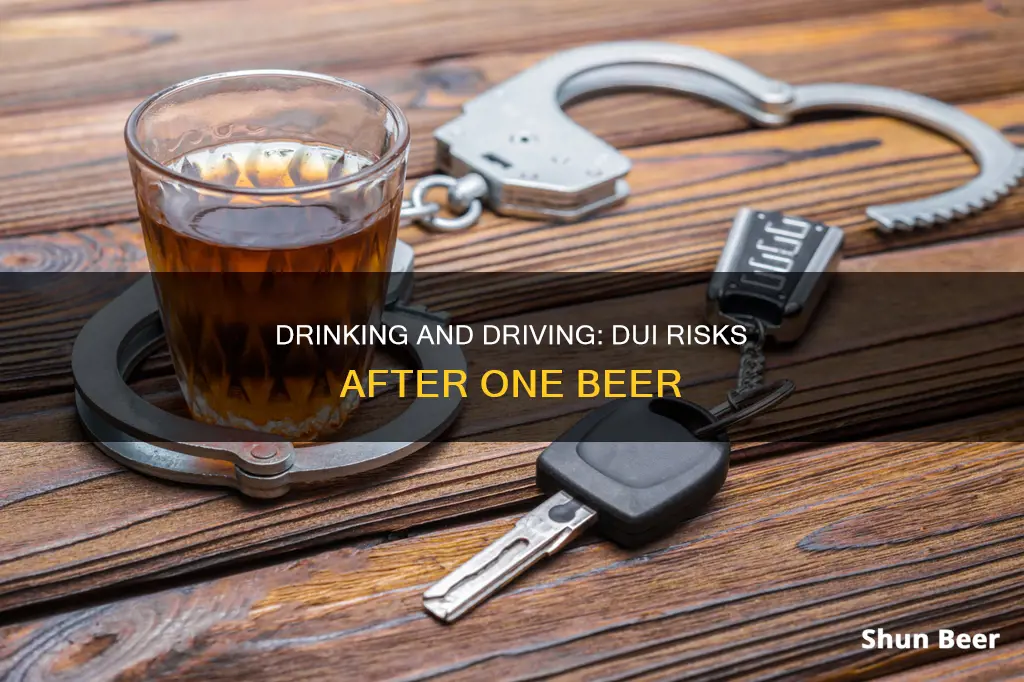
It is a common misconception that drinking one alcoholic beverage is safe before driving. While it is unlikely to cause a Blood Alcohol Concentration (BAC) level of over 0.08%—the legal limit in most states—drinking just one beer can still lead to a DUI charge. This is because any level of impairment behind the wheel is illegal, and a single drink can affect your capacity for tracking moving objects, your ability to multitask, and your visual acuity. Moreover, zero-tolerance laws in some states mean that any blood alcohol content can lead to an arrest for those under 21.
| Characteristics | Values |
|---|---|
| Blood Alcohol Concentration (BAC) limit | 0.08% |
| One drink an hour rule | May not be effective |
| Factors affecting BAC | Sex, weight, amount of food consumed, drink size, drinking duration, type of alcohol |
| Zero-tolerance laws | Applicable to drivers under 21 years of age in certain states |
| Impairment | Determined by a police officer |
| Breathalyzer | Can produce false positive readings |
What You'll Learn

Zero-tolerance laws for under 21s
Zero-tolerance laws are strict rules with severe consequences for all offenders, usually without exception. In the context of drinking and driving, these laws are intended to combat the dangers of underage drinking. In the United States, it is illegal for anyone under the age of 21 to purchase, possess or consume alcohol. Zero-tolerance laws make it a criminal DUI offence for drivers under 21 to operate a vehicle with even a small amount of alcohol in their system. This limit ranges from 0.00% to 0.02% blood alcohol concentration (BAC), depending on the state.
The concept of zero-tolerance laws regarding drinking and driving can be summed up as "illegal to drink, illegal to drive". This means that, because it is illegal to drink alcohol under the age of 21, it should also be illegal for them to drive while under the influence of any detectable amount of alcohol, no matter how small. All 50 states have zero-tolerance laws for underage drivers, though the BAC amounts and consequences vary. In many states, underage drivers can be penalised for operating a motor vehicle with BAC levels as low as 0.00%, 0.01% or 0.02%—any detectable amount of alcohol is against the law and can result in an underage DUI charge.
Zero-tolerance laws are effective. A 1995 study found that the first states to set a 0% BAC limit for certain young drivers saw a 22% decline in fatal single-car nighttime crashes. States with a 0.02% limit saw a 17% reduction. A 1999 study linked zero-tolerance laws to a 24% drop in the share of crashes linked to underage drinking. Additionally, a 2012 study estimated that zero-tolerance laws save 19 to 29 lives each year.
However, enforcement and publicity for zero-tolerance laws appear to be rare. Studies have found that young drivers are not arrested in proportion to their involvement in alcohol-related crashes. One exception is Washington State, where a study found that arrests for alcohol violations among 16- to 20-year-old drivers increased by about 50% after the zero-tolerance law went into effect.
Beer After Work: Relax, Unwind, and Socialize
You may want to see also

Impairment and the legal limit
It is a common misconception that drinking one beer is not enough to put you over the blood alcohol concentration (BAC) limit of 0.08%. However, this limit varies depending on factors such as age, sex, weight, and the type of alcohol consumed. For example, in the state of Georgia, a zero-tolerance law states that if you are under 21 years of age and have a BAC of 0.02% to 0.05%, you can be arrested for DUI. Similarly, in Florida, if you are under 21 and your BAC is 0.02%, your license will be suspended.
Even if you are over 21, a single standard drink can get your BAC level to around 0.02%, which is below the legal limit of 0.08% but still enough to affect your capacity for tracking moving objects, your ability to multitask, and your visual acuity. This impairment can put you at risk of an accident and make you more likely to be pulled over by the police. Additionally, breathalyzers can sometimes give false positive readings, especially if you consumed an alcoholic drink just before being stopped by the police.
It is important to remember that you do not have to break the legal limit to get a DUI; just being impaired is enough. The type of drink and the amount of alcohol consumed also play a role. For example, one beer that is 5% alcohol consumed over an hour is likely to be metabolized by the body, but drinks such as gin or whiskey have a much higher alcohol content, and even wine can have two to three times as much alcohol as beer.
To avoid any risk of DUI or accidents, it is best to refrain from drinking and driving altogether. If you plan on drinking, consider alternatives such as taking a cab, riding with a designated driver, or drinking at home.
Antibiotics and Alcohol: Safe Mix When Treating Chlamydia?
You may want to see also

Sex, weight, and metabolism
Weight is also a factor in BAC, as body weight determines the amount of space and mass in which alcohol can diffuse throughout the body. A heavier person will generally have a lower BAC than a lighter person who has consumed the same amount of alcohol.
Metabolism also influences how quickly alcohol is processed by the body. People with a higher metabolism may be able to process alcohol more quickly, meaning it may take more drinks for them to become intoxicated. On the other hand, body fat and height may make someone a "heavyweight" drinker, meaning they can consume more alcohol before becoming impaired.
In addition to sex, weight, and metabolism, other factors such as the amount of food consumed before or during drinking, the size and type of drinks, and the duration of drinking can also impact a person's BAC. It's important to note that everyone's body processes substances like alcohol differently, and there are no hard and fast rules for how alcohol will affect an individual.
When it comes to driving under the influence (DUI), it's important to remember that any level of impairment behind the wheel is illegal. While the legal BAC limit is typically set at 0.08%, even a single drink can impair a person's ability to drive safely. As such, it's always best to err on the side of caution and avoid driving after consuming alcohol.
Breast Cancer and Beer: Is It Safe to Drink?
You may want to see also

Drink size and alcohol content
The amount of alcohol in a drink is measured by its alcohol by volume (ABV) percentage. The higher the ABV, the less volume of the drink is needed to reach the legal blood alcohol concentration (BAC) limit of 0.08%.
The ABV of drinks varies within and across beverage types. For example, a typical beer has an ABV of 5%, but this can range from 3% to 7%, with some craft beers reaching 12% ABV. A "light beer" will have an even lower ABV of between 2% to 4%. A typical glass of wine is 12% ABV, but this can range from 9% to 14% ABV, and some wines are "fortified" with distilled alcohol, increasing the ABV to 16-24%.
The ABV of spirits is generally higher than that of beer and wine. A typical shot of hard liquor is 40% ABV, but this can range from 36% to 50% ABV, and some spirits can have an ABV as high as 95%.
The size of a drink is also important to consider when thinking about ABV. A "standard" drink in the United States is defined as any beverage containing 0.6 fl oz or 14 grams of pure alcohol. This is equivalent to 12 ounces of regular beer, 5 ounces of wine, or 1.5 ounces of distilled spirits. However, it's important to note that serving sizes may not always match the standard drink size. For example, cocktails and mixed drinks may contain more alcohol than a single standard drink, depending on the recipe and the pour.
Additionally, factors such as sex, weight, and whether food was consumed before or with the drink can also affect how alcohol is metabolized and absorbed by the body. As a result, two people consuming the same drink size and ABV can have different BAC levels.
Therefore, it's important to understand that while the ABV and size of a drink are factors in determining BAC levels, individual factors also play a significant role. To stay within the legal BAC limit, it's recommended to plan ahead and consider alternatives to driving if there is any doubt about your ability to do so safely.
Beer and Plasma: What's the Safe Combination?
You may want to see also

Breathalyzer errors
Breathalyzers are commonly used by law enforcement to measure a person's blood alcohol content (BAC). While they are the most widely used tool to evaluate an individual's BAC, they are not always accurate. Studies have shown that there is a 50% margin of error between breathalyzer results and actual BAC. This means that a breathalyzer reading of .1% could range between .05% and .15%. This margin of error can mean the difference between a conviction and a "not guilty" verdict.
There are several factors that can contribute to a false positive or inaccurate breathalyzer reading:
- Equipment calibration: Breathalyzers must be routinely tested and calibrated to ensure accuracy. Air temperatures can also affect calibration.
- Medical conditions: Individuals with diabetes or hypoglycemia may have high acetone levels that trigger a false positive. Other conditions such as acid reflux and heart disease can also affect breathalyzer results.
- Medications: Certain medications, including cold and allergy medicines, cough syrups, and heartburn and acid reflux medications, can increase BAC or otherwise affect breathalyzer results.
- Mouth contaminants: Mouthwash, toothpaste, breath strips, sprays, and mints can cause a false positive, as they often contain alcohol.
- Food and beverages: Some foods and beverages contain low levels of alcohol that are not intoxicating but can skew breathalyzer readings. These include fermented drinks like kombucha, ripe fruits, energy drinks, protein bars, non-alcoholic wine and beer, hot sauce, some nuts, and cinnamon.
- Other products: Products such as perfumes, colognes, aftershave, hair sprays, bleach, air fresheners, insect repellent, hand sanitizers, and cleaning wipes contain alcohol and can alter breathalyzer results.
- Electronic interference: Electromagnetic and radio frequency interference from power lines, radios, cell phones, and other electronic devices can interfere with breathalyzer readings.
- Temperature: Body temperature, air temperature, and weather temperature can all impact breathalyzer results. A higher body temperature can increase BAC readings, and breathalyzers should be calibrated to account for outdoor temperatures.
- Breathing rate: An individual's breathing rate can affect their BAC reading. Vigorous exercise, hyperventilation, or holding one's breath can substantially impact the BAC rate.
- Chemical compounds: Breathalyzers measure the level of the methyl group of chemical compounds, which may be present in an individual's breath due to exposure to gasoline, oil-based paint, propane, varnish fumes, or certain medications.
It is important to note that even if you feel sober enough to drive, your BAC could still be above the legal limit. The legal limit for BAC is typically set at 0.08%, but this may vary depending on local laws and your age. In some states, such as Georgia, there is a zero-tolerance law for drivers under 21 years of age, with a legal limit of 0.02% to 0.05%.
Beer and Seizure Medicine: What You Need to Know
You may want to see also
Frequently asked questions
It depends on a variety of factors. While the legal Blood Alcohol Concentration (BAC) limit in most states is 0.08%, you can still get a DUI if a police officer deems you impaired. Factors that can influence your BAC include your sex, weight, the amount of food in your stomach, the alcohol percentage of your drink, and how long you've been drinking.
Body weight determines the amount of space and mass in which alcohol can diffuse in the body. A person who weighs 160 lbs will have a lower blood alcohol concentration than a 120-lb person who drank the same amount.
Food in the stomach slows the rate at which alcohol is absorbed into the body. The pyloric valve at the base of the stomach closes when there is food present, delaying the absorption of alcohol.
A typical 12-ounce beer is about 5% alcohol. An average man weighing 180 lbs who has two 12-ounce beers would expect to reach a peak BAC of only 0.043%average woman weighing 160 lbs would expect to reach a peak BAC of 0.057%







